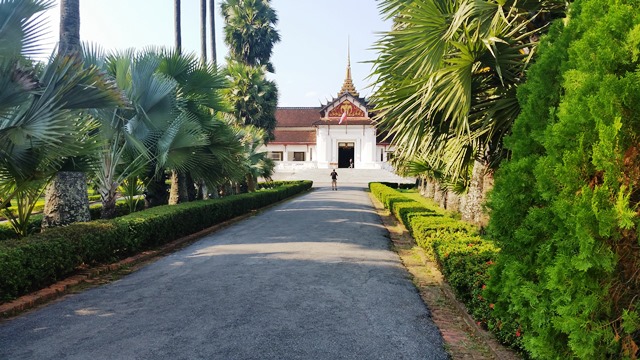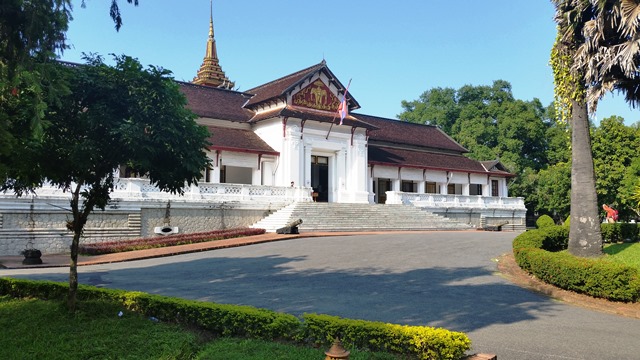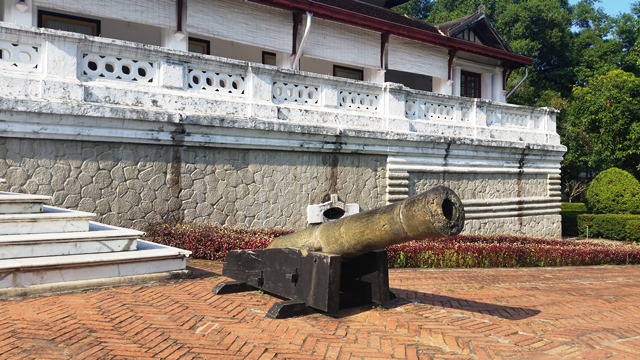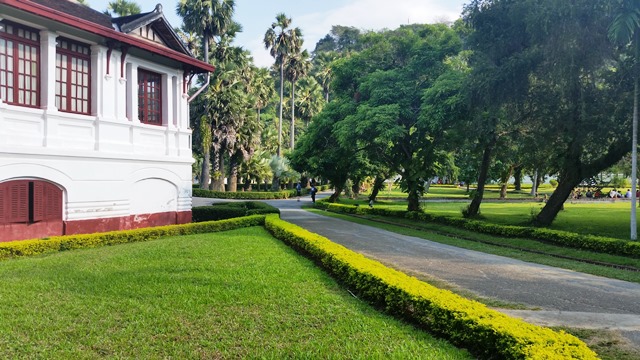The Royal Palace Museum in Luang Prabang
The Luang Prabang Royal Palace Museum is a place I would really like to get my hands on. It has so much potential that is just not being realised.
The building is one of the more impressive in Luang Prabang; it has the history, location, and desire to be so much more than it is and I can’t help feeling that it could be much more than just something else to do for a couple of hours while you are in Luang Prabang. Makes me wonder who I could talk to…
Don’t get me wrong though. If you are visiting Luang Prabang it is well worth your time to have the Royal Palace Museum on your list of things to visit. It’s not expensive, it’s a fascinating glimpse into a bit of Lao history and some of the buildings features and decorations are spectacular. Don’t pass it by.
The Museum is open from 8.00am – 11.30am and again from 1.30pm – 4.00pm. The large gates at the entrance will be shut outside these hours but an impressive photo of the building and grounds can be taken from the steps leading up Mount Phousi on the opposite side of the road.
The entry fee is 30,000 kip (approx. $3.75) and can be obtained from the ticket office just inside the gate on your left. Buy your ticket when you walk in to avoid being stopped at the Museum itself and forced to do the walk of no-ticket-shame back to get one.
Clutching your ticket you can now walk up the driveway, past the two canons and up the marble steps of the Museum.
Which is where we come to the problem. I have been told that the canons were once mounted at the top of Mount Phousi enabling the military a 360° field of view. This is not something I can confirm, although it makes sense to me, and there is nothing on the canons to give their history. This lack of labelling and information regarding what you are seeing is one of my main issues with the Museum and something I would be happy to help fix. I love museums and find that knowing what I’m looking at makes the experience so much more enjoyable. Okay, rant over…back to the Museum.
If you take the time to read the back of your ticket you will know that you are required to take your shoes off before entry and to leave your bags outside as well. There is a shoe rack and a locker room at the top of the stairs and to the left for this. You are also not allowed to take photos inside so you have to leave your camera as well. The ticket also asks that out of respect you dress with your midriff, upper arms and upper legs covered. If you are even the tiniest bit culturally sensitive you’ll already be dressed this way while you are visiting Laos.Now you can have your ticket scanned and a hole punched into it before entering the Museum proper.
The first room is the Protocol room and would have been the setup before entering the larger Throne Room behind it to see the King. The high ceilings and timber floors here carry on throughout the entire building. Don’t forget to look up at the chandelier.
A small sign in this room gives a short history. The Palace was built between 1904 and 1909, during the French Colonial period for King Sisavangvong. The sign then reveals that the Palace became the Royal Palace Museum in 1976. Obviously this was when King Sisavang Vatthana was removed and there was no longer a need for a Royal Palace. I’m pleased that the building was preserved.
From the Protocol Room you are guided by arrows and a velvet rope to the room on the right. This is the King’s Reception Room, a more intimate and presumably workable space than the Throne Room.
But it’s the walls that are of interest here. They are covered in murals painted in 1930 by influential French artist Alix Aymé, (Alix de Fautereau at the time of the painting, she later married Colonel Georges Aymé). The murals show landmarks and daily life at the time in Luang Prabang and the view of the bamboo bridge seems identical to the one you can still see today.
At the end of the room are busts of three previous Lao Kings. King Ounkham (ruled 1872 – 1888), King Khamsouk (ruled 1890 – 1904) and King Sisavangvong (ruled 1905 – 1959).
From the Reception Room you follow a hallway to the left a short distance into the Throne Room. Don’t miss the 1827 Royal howdah to the right at the end of the hall before you go into the Throne Room.
The Throne Room is undoubtedly the most spectacular room in the Museum. It seems that every inch of wall space has been covered with scenes of Lao folktales, customs and ceremonies made from glass mosaic tiles. They are multi coloured and sparkle in whatever sunlight can find its way into the room. Take the time to have a good look at these mosaics, there are entire stories shown with everything from simple home life to elaborate battles.
The Throne Room also has the gilt Royal Throne, a given considering the name I guess. This is the room that would have been designed to impress visitors and with the large gold throne and the glittering mosaic walls it would have done a good job.
The room also contains cabinets housing an impressive collection of Buddha figurines made from various materials. Again, the lack of labelling and information is an issue here.
From the Throne Room it is into another hallway that circles the back end of the building. This was the private quarters of the Royal family and the rooms are said to be presented as they were at the departure of the King. The hallway itself is home to cabinets displaying everything from items of Royal clothing to seals, daggers and a collection of the Kings pipes. There are also a number of stone tablets marking the building of temples as far back as 1527.
On the walls of the hallway are 16 paintings showing the Buddhist legend of Prince Wetsantara that lay out the tale as you walk around.
The first room is a private reception room, now looking a bit empty but, of interest, if a bit hard to see, is a cabinet presented by Gerrit van Wuysthoff of the East India Company in the 1670’s, according to the sign. This is exactly the sort of thing that probably needs to be researched a bit more and authenticated, then presented to visitors with more details.
Next is the Queen’s bedroom, a large sparse room that may well have been decorated and furnished a little more warmly when she was in residence. The only real evidence of any personal touches are a few family pictures on the wall.
Then it’s the King’s bedroom. An even larger room that is equally sparse and is dominated by an intimidating painting of the King’s Father. I’m really not sure if that would have been in place when the king was trying to sleep there.
Then on to the children’s bedroom which now houses a collection of traditional Lao instruments and costumes from the Royal Ballet.
The last of the family rooms on display is the dining room, with a large table in the middle, set for a meal and a number of sideboards around the walls displaying various items of crockery and cutlery.
From here it’s back through the Throne Room to a short hallway that contains the original certificates proclaiming Luang Prabang’s World Heritage status. Signed in 1995 they are an important part of Luang Prabang’s history but are easy to miss if you don’t know what they are and their significance.
Now you end up in the Queen’s Reception Room, the mirror of the King’s room on the other side of the building where you entered. This room seems a bit more utilitarian without the murals decorating the King’s. The room contains gifts given to Laos by various foreign governments and appears to be separated by political (eg communist) leanings. It was interesting for me to note that while the USA gave flags that had been carried to the moon aboard Apollo II and Apollo XVII along with moon rocks collected on those flights, Australia had given a wooden boomerang.
Now you move back outside to collect your bag and shoes. But don’t leave just yet, the Museum grounds are worth a look as well.
If you walk to the back of the Palace on the right you will find the King’s car collection. Not the most mind blowing collection of automotive history, it consists of a Jeep that was a gift from Japan, a couple of Lincoln Continentals from the 50’s and 60’s that were presented by the USA as well as an Edsel and a Citroen. All of the cars seem to be in the need for a little loving care but they are testament to a time when cars like these would have been a status symbol in Laos and obviously worthy of belonging to the Royal family.
Continue on around the back of the building you can see the care that still goes into the grounds and gardens. In fact the entire building seems to be well cared for, I couldn’t see any dust in any of the rooms inside despite that being a real issue in this town everywhere.
Walk on and back towards the front of the Museum and you will find a large circular fish pond on the right (as you face back towards the gate). This is full of an enormous number of hungry fish who will somehow manage to have an expectant look on their faces as you circle the pond. Fish food is for sale at 5,000 kip a bag which explains the looks.
Also in the Museum grounds are the Theatre, which has nightly performances of traditional dance and music, and the Prabang temple housing the Prabang statue which gives the town its name. Both of these will be subjects of their own posts in the future.
So, that’s the Royal Palace Museum in a nutshell. Not exactly the British Museum or the Smithsonian but certainly shouldn’t be dismissed as something you don’t need to visit while you are in Luang Prabang. It will give you a brief insight into the past and perhaps an extra facet to Laos itself.




